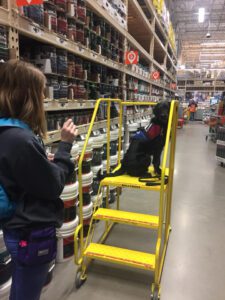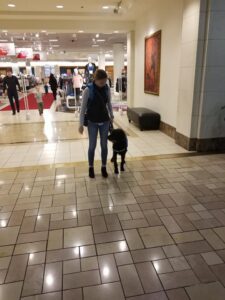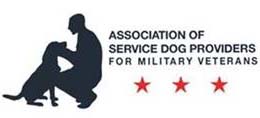Post Contributed by Madie Sanford
2019 already and the making of a service dog project continues. I have asked the participants of this project to contribute blog posts from time to time. Madie Sanford, one of Major’s trainers, returned to Idaho during the Christmas break, taking Major with her. The two of them have been working every day and, as part of the work, Madie has provided an interesting perspective. For those interested in having a service dog, please read this and think very carefully before you jump into it.

Madie here. I am one of two trainers who is handling and training Major, the psychiatric service dog in training (SDiT). As stated previously, he is a special case and will be fully trained in six months. Normally, it takes two years to fully train a service dog, so we have a lot of progress to make in a short time frame!

Out in stores, everyone I pass stares. Almost everyone I pass says “puppy” or “aww so cute”. Some people ask what breed Major is. One person complimented Major’s good behavior. But, no one is fully considerate and understanding of my SDiT. There are many things I thought about service dog trainers before – how it must be fun to have a dog in public, how cute the dogs are, and how amazing the tasks they perform are. Now that I am on the inside looking out, I wish I never thought those things. Having a service dog in public is anything but fun. I am terrified of running into a fake service dog (which I have several times). I am terrified of people petting Major without asking. And it is extremely difficult to handle people who talk to Major and get upset when I say they are not allowed to pet him. Major is not a pet, to me or his future handler. This is a concept the general population struggles to understand.
It’s also difficult to navigate stores. I am no longer just walking by myself. I am trying to push my way through the crowd, keep an eye on Major to ensure his safety, and trying not to pay attention to all the people gawking. Many people do not step aside when you come through with a dog, despite needing extra space. However, this is where Major’s tasks come into play. If you’re following his Facebook page (@MajorSDiT), we talk about blocking, grounding, and posting. These are the main three tasks performed in public. Blocking is when Major becomes perpendicular to the handler and prevents strangers from approaching too quickly or too close. Posting is when Major sits on my right side, keeping a lookout behind me. He then will learn to nudge my leg when someone is approaching. Lastly, grounding is helpful for someone with anxiety in public. Major gets perpendicular behind his handler and presses against his/her legs.

Another aspect of being a service dog trainer is considering the actions and behaviors of your friends and family. Your family members and friends are exposed to the service dog when they are “off-duty”, which means they are allowed to be a normal dog. However, as soon as the vest goes on, the family must remember not to talk or pet the service dog.
Overall, my experience as a service dog trainer has been rewarding. I am learning so much from DeeDe, Tom Brownlee (an adjunct professor at Carroll College), Ali (who is helping train Major), and from many others not even familiar with training dogs. Every situation is a training opportunity. As long as I am alert and have some kibble, Major is always learning, and I am always learning, too.




